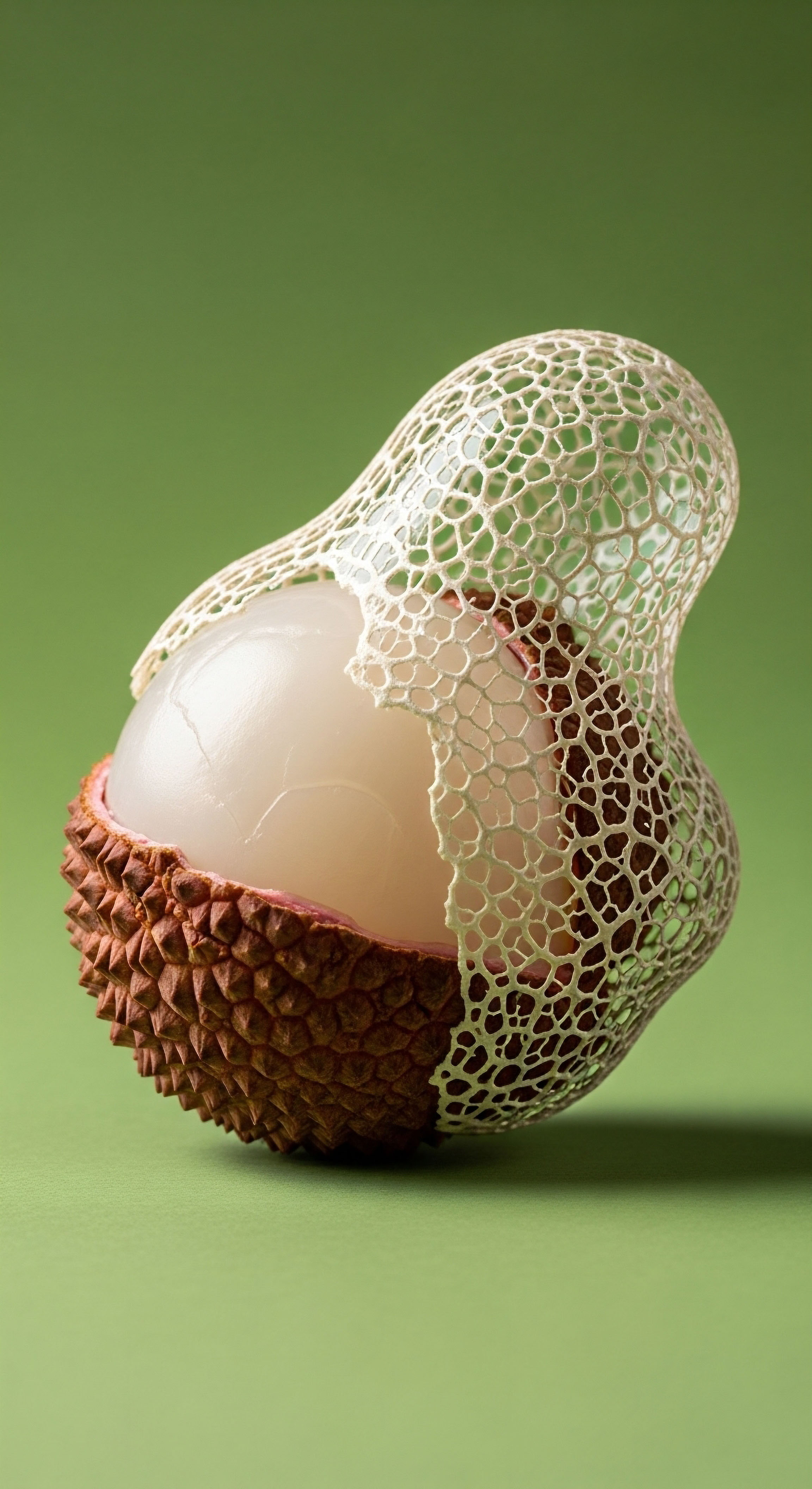

Fundamentals
You may have held a vial of your prescribed hormone therapy, noting the testosterone or estradiol is suspended in a specific oil. It is a detail that feels secondary to the active hormone itself, yet your body’s ability to use that hormone is profoundly connected to the properties of its liquid vehicle.
The sensation of a preparation on your skin, its thickness or thinness, is a physical clue to its underlying biochemical function. This journey into understanding your own biological systems begins with appreciating how every component of your protocol is designed to work with your body, starting at the most fundamental interface ∞ your skin.
Your skin is an extraordinary organ, engineered over millennia to be a formidable shield. Its outermost layer, the stratum corneum, is a highly organized structure of flattened, deceased skin cells called corneocytes, embedded within a specialized lipid matrix.
Think of this as a microscopic brick-and-mortar wall; the corneocytes are the bricks, and the lipids ∞ a mixture of ceramides, cholesterol, and free fatty acids ∞ are the mortar. This lipid mortar is hydrophobic, meaning it repels water, creating a barrier that is exceptionally effective at keeping external substances out and essential bodily fluids in.
Hormones used in topical therapies, such as estradiol and testosterone, are themselves lipophilic, or fat-soluble. They have a natural affinity for the lipid components of this barrier, which is a prerequisite for their passage.
A carrier oil acts as a specialized delivery vehicle, designed to help therapeutic hormones navigate the skin’s protective lipid barrier.
A carrier oil in a transdermal hormone preparation is the designated vehicle for navigating this barrier. These oils are primarily composed of triglycerides, which are molecules consisting of a glycerol backbone attached to three fatty acid chains.
When a hormone is dissolved in a carrier oil and applied to the skin, the oil itself begins to interact with the stratum corneum’s lipid mortar. The fatty acids within the carrier oil temporarily and reversibly disrupt the highly ordered structure of the skin’s lipids.
This action fluidizes the barrier, creating transient pathways that allow the dissolved hormone molecules to permeate through the stratum corneum and reach the living layers of the epidermis and dermis below, where they can be absorbed into the bloodstream.

The First Step in Bioavailability
The process of absorption begins the moment the preparation makes contact with your skin. The carrier oil’s primary job is to overcome the skin’s resistance. It does this by merging with the skin’s own oils, subtly altering the chemistry of that protective layer. This is a delicate biochemical negotiation.
The oil must be compatible enough to integrate with the stratum corneum lipids but disruptive enough to increase their permeability. This initial step determines how much of the hormone even begins the journey into your system, directly influencing the efficacy of your prescribed hormonal optimization protocol. The selection of an appropriate carrier is therefore a foundational element of designing an effective transdermal therapy.


Intermediate
Moving beyond the basic concept of a delivery vehicle, we can examine the specific physicochemical properties of a carrier oil that dictate its performance. The effectiveness of a transdermal hormone formulation is a direct result of the molecular interplay between the hormone, the carrier oil, and the lipids of the stratum corneum.
The chemical structure of the oil’s constituent fatty acids is arguably the most significant factor determining its ability to enhance penetration. This is where the true engineering of a therapeutic preparation becomes apparent.
Fatty acids are categorized based on the chemical bonds in their long hydrocarbon tails. Saturated fatty acids have straight, flexible chains with only single bonds, allowing them to pack together tightly. Unsaturated fatty acids, conversely, contain one or more double bonds, which introduce rigid kinks or bends into their structure.
It is this structural difference that is key to their function as penetration enhancers. When unsaturated fatty acids from a carrier oil are introduced to the stratum corneum, their kinked geometry prevents them from packing neatly alongside the skin’s own highly ordered lipids.
This geometric disruption increases the fluidity of the lipid matrix, creating microscopic, disordered pockets through which hormone molecules can more easily pass. Oleic acid, a monounsaturated fatty acid abundant in olive oil, is a classic example of a potent penetration enhancer due to this mechanism.
The degree of saturation in a carrier oil’s fatty acids directly modulates the fluidity of the skin’s lipid barrier, governing hormone absorption.

Key Properties Influencing Absorption
Several distinct properties of the carrier oil and the hormone itself work in concert to determine the ultimate bioavailability of the therapy. Understanding these variables clarifies why one formulation may be more effective than another for a specific individual or application.
- Fatty Acid Profile The ratio of saturated to unsaturated fatty acids is paramount. Oils with a high percentage of unsaturated fatty acids, like linoleic or oleic acid, are generally more effective at fluidizing the stratum corneum than those high in saturated fats.
- Lipophilicity and Partition Coefficient (Log P) A hormone must be soluble in the carrier oil to be delivered effectively. However, for it to move from the oil, through the lipid stratum corneum, and into the more watery environment of the deeper skin layers, it needs a balanced solubility. The partition coefficient, or Log P value, quantifies this. An optimal Log P is typically between 1 and 3, indicating sufficient lipophilicity to cross the lipid barrier but enough water solubility to enter the aqueous dermal tissue and capillaries.
- Occlusivity Some oils form an occlusive film on the skin. This film traps moisture, leading to over-hydration of the stratum corneum. A well-hydrated stratum corneum is significantly more permeable than a dry one, which can substantially increase the absorption rate of a topically applied hormone.
- Viscosity The thickness of an oil affects how evenly it spreads and how long it remains on the skin’s surface. A more viscous oil may provide a longer, more sustained release profile, while a less viscous oil might be absorbed more quickly.

Comparative Analysis of Common Carrier Oils
The choice of a carrier oil in a compounded hormone therapy is a clinical decision based on these properties. The following table provides a simplified comparison of oils sometimes used in topical formulations, highlighting the characteristics relevant to hormone absorption.
| Carrier Oil | Dominant Fatty Acid Type | Key Physicochemical Property | General Impact on Absorption |
|---|---|---|---|
| Olive Oil | Monounsaturated (Oleic Acid) | High concentration of a known penetration enhancer. | Effectively disrupts lipid barrier for enhanced permeation. |
| Coconut Oil (Fractionated) | Saturated (Medium-Chain) | Low viscosity, good spreadability, less occlusive. | Provides good solubility for hormones but is a less aggressive penetration enhancer. |
| Jojoba Oil | Monounsaturated (Gadoleic Acid) | Structurally similar to human sebum, highly stable. | Integrates well with skin lipids, offering gentle enhancement. |
| Almond Oil | Monounsaturated (Oleic Acid) | Balanced profile with good emollient properties. | Provides moderate penetration enhancement with good skin feel. |


Academic
At a molecular level, the influence of a carrier oil on hormone absorption is a study in lipid biochemistry and membrane biophysics. The stratum corneum’s intercellular lipid domain exists as a highly structured, lamellar gel phase, characterized by tightly packed, mostly saturated, long-chain ceramides, cholesterol, and free fatty acids.
This crystalline arrangement is what makes it such an effective barrier. The introduction of specific exogenous fatty acids, delivered via a carrier oil, induces a phase transition in localized regions of this matrix, moving it from a well-ordered gel state to a more fluid, liquid crystalline state. This is the central mechanism of action for many penetration enhancers.
Unsaturated fatty acids, particularly cis-isomers like oleic acid, insert themselves into the lipid lamellae. Their kinked C18 chains create steric hindrance, pushing apart the adjacent straight-chain lipids of the stratum corneum. This increases the intermolecular volume and lowers the phase transition temperature of the lipid matrix, effectively creating disordered micro-domains.
These fluid pockets exhibit significantly higher diffusion coefficients, serving as preferential pathways for the transport of lipophilic molecules like steroid hormones. The efficiency of this process is quantifiable by the change in the permeability coefficient (Kp) of the hormone, a key parameter in pharmacokinetic modeling. Studies have demonstrated a direct correlation between the concentration of an effective fatty acid enhancer and a quantifiable increase in the Kp for drugs like estradiol and testosterone.

How Does Carrier Composition Affect Pharmacokinetic Profiles?
The choice of carrier oil directly modulates the pharmacokinetic profile of a transdermal hormone, influencing key parameters such as the maximum plasma concentration (Cmax), the time to reach that peak (Tmax), and the total drug exposure over time (Area Under the Curve, AUC).
A highly efficient carrier containing potent penetration enhancers will result in a more rapid onset of absorption, leading to a shorter Tmax and a higher Cmax. This might be desirable for acute symptom relief.
Conversely, a carrier designed for a more controlled, sustained release might use a different lipid composition that moderates the disruption of the stratum corneum, resulting in a lower Cmax and a prolonged absorption phase, which is often the goal in long-term hormonal optimization protocols to mimic natural diurnal rhythms and maintain stable serum levels.

Systemic Implications of Carrier Selection
The consistency of hormone absorption is critical for maintaining the delicate balance of the body’s endocrine signaling systems, such as the Hypothalamic-Pituitary-Gonadal (HPG) axis. An improperly formulated carrier can lead to erratic absorption, causing peaks and troughs in serum hormone levels. These fluctuations can send confusing signals to the pituitary gland.
For instance, in male Testosterone Replacement Therapy (TRT), a sudden spike in testosterone can lead to increased aromatization into estradiol. The body’s feedback mechanisms might then downregulate endogenous production of Luteinizing Hormone (LH) and Follicle-Stimulating Hormone (FSH) more aggressively.
A well-designed transdermal system aims for steady-state kinetics that provide consistent symptom management while minimizing such disruptions to the HPG axis. The carrier oil is not an inert excipient; it is a critical determinant of the therapy’s physiological impact.
The carrier oil’s molecular structure directly dictates the pharmacokinetic reality of hormone therapy, influencing systemic stability and clinical outcomes.
The following table details specific fatty acids and their established roles in modulating skin permeability, providing a more granular view of the science behind formulation design.
| Fatty Acid | Chemical Structure | Mechanism of Action | Observed Effect on Permeability |
|---|---|---|---|
| Oleic Acid | C18:1 (Monounsaturated) | Creates significant disorder and fluidization in stratum corneum lipids. | Potent and widely studied penetration enhancer for both lipophilic and hydrophilic drugs. |
| Linoleic Acid | C18:2 (Polyunsaturated) | Multiple double bonds create greater disruption and fluidity. | Very effective enhancer, though may increase potential for skin irritation in some individuals. |
| Stearic Acid | C18:0 (Saturated) | Straight chain integrates into lipid lamellae without significant disruption. | Minimal to no penetration enhancement effect; can increase barrier integrity. |
| Lauric Acid | C12:0 (Saturated) | Shorter chain length allows for some lipid fluidization. | Moderate enhancement, particularly through interaction with sebaceous pathways. |
Ultimately, the academic understanding of carrier oil properties allows for the rational design of transdermal systems. By selecting oils with specific fatty acid profiles, formulators can tailor the release rate and bioavailability of a hormone to match the therapeutic goals of sophisticated clinical protocols, including TRT for men and women, and other endocrine system support strategies.

References
- Herman, A. and A. P. Herman. “Systematic Review on the Effectiveness of Essential and Carrier Oils as Skin Penetration Enhancers in Pharmaceutical Formulations.” MDPI, vol. 9, no. 11, 2020, p. 2366.
- Narishetty, S. and R. Panchagnula. “Physicochemical and Pharmacokinetic Parameters in Drug Selection and Loading for Transdermal Drug Delivery.” Indian Journal of Pharmaceutical Sciences, vol. 66, no. 6, 2004, pp. 697-704.
- Sharma, G. et al. “Enhancement strategies for transdermal drug delivery systems ∞ current trends and applications.” Journal of the Indian Institute of Science, vol. 101, no. 1, 2021, pp. 119-137.
- Wosicka-Jurczak, K. and A. P. Herman. “Natural Ingredients of Transdermal Drug Delivery Systems as Permeation Enhancers of Active Substances through the Stratum Corneum.” Molecular Pharmaceutics, vol. 20, no. 7, 2023, pp. 3473-3489.
- Stanczyk, F. Z. and D. F. Archer. “Pharmacokinetics and bioavailability of estradiol and progesterone.” Steroids, vol. 76, no. 1, 2011, pp. 1-16.

Reflection

What Does This Mean for Your Protocol
You have now seen the journey a hormone molecule must take, from its suspension in a carrier oil to its arrival in your bloodstream. This process is governed by a cascade of biochemical interactions, where the properties of the oil are as meaningful as the hormone itself. This knowledge transforms your perspective.
Your therapeutic protocol is a complete system, and the carrier vehicle is an active, functional component within that system. As you continue on your path toward metabolic and hormonal optimization, consider how this deeper understanding of the formulation’s design can inform the conversations you have with your clinical team. Recognizing the science behind the substance allows you to become a more active, informed participant in your own health narrative, appreciating the precision required to recalibrate your body’s intricate signaling networks.



